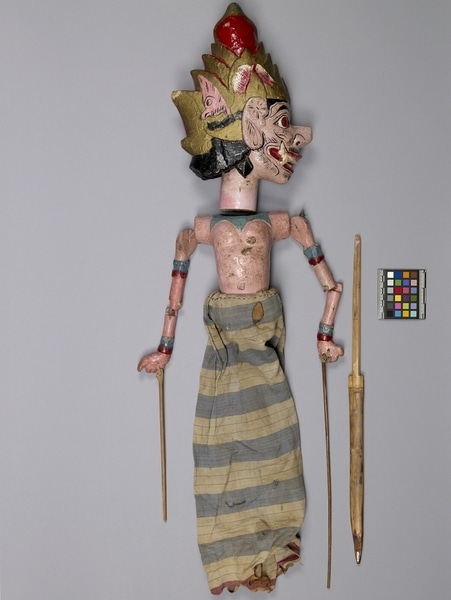Rod Puppet Item Number: Ib357 from the MOA: University of British Columbia


Description
A three-dimensional male humanoid figure puppet. Has a large head and jointed arms attached to controlling rods. The pink face is positioned forward with exaggerated features that include large red eyes with red irises, an open mouth with exposed teeth, and pair of overlapping fangs at each corner, red lips, and a blunt nose. Facial hair (moustache, beard, sideburns) and facial details are in black. Wearing a Mahkota (crown) headdress with large diadem, karawista, Garuda Mungkur (short-tongue) in red, and gold, pink, white, and black. Slight black hair extends from beneath the crown. The upper torso is corpulent with a large belly, uncovered except for a five-pointed blue collar. There is a pair of red and blue ornaments at the wrist and bicep of each arm. Both hands are clenched with thumbs partly extending. Wearing a skirt that has wide blue and beige horizontal stripes with the beige stripes subsectioned with fine blue pinstripes.
History Of Use
Javanese puppetry as an art form probably developed by the 11th century. Wayang golek puppets of western Java appeared during the 16th century. Originally the plays depicted Javanese mythology, but after the Indian conquest of Java the Hindu epics, Ramayana and Mahabharata, were incorporated into the cycles, which comprise about 200 plays. A dalang (puppet master) performs the plays to celebrate important occasions, usually in three acts, with vocal and instrumental accompaniment. Typically they serve a moral and religious purpose, and more recently, one of political commentary. A manifestation of a puppet is a deliberate variation to reflect a physical or spiritual change in a character, such as, respectively, disguise or aging, anger, or maturation. This puppet is almost certainly a manifestation of Arimba, prabu (king) of Pringgadani in the Mahabharata cycle of plays. The cycle chronicles the conflict between the Pandawa brothers and their usurpers, the Kurawa brothers. Arimba is persuaded by the Kurawas to become allied with them in their (ultimately failed) usurpation. The rakshasa are an indigenous addition to the Indian epics, providing an additional foe to the protagonists.
Cultural Context
Theatrical performance.
Iconographic Meaning
Each puppet is characterized by it's wanda, a Javanese word which describes the specific mixture of elements of size, form, colour, ornamentation and carving. Colour of face and eyes suggests aggressiveness; position implies irreverence and spiritual disharmony. Grotesque features are not refined. Huge body and uncovered chest, fangs identify puppet as giant (rakshasa). Bare chest suggests that puppet is not descended from humans. Skirt is unrefined, and varies from the expected batik. Crown extremely distinguished; crown may only be worn by kings or gods. Garuda also suggests high rank. Position of hands unusual, typically associated with pandita (priests). Character almost certainly a manifestation of Arimba, identified on the basis of the crown, which is worn by no other raksasa. Variations include dress, amount of hair, and position of hands, but are not significant in identification (in this case).
Item History
- Made in Java, Indonesia
- Owned by Tradewind Antiques before March 15, 1983
- Received from Museum of Anthropology Shop Volunteers (Funding source) and Tradewind Antiques (Seller) on March 15, 1983
What
Who
- Culture
- Sundanese
- Previous Owner
- Tradewind Antiques
- Received from
- Museum of Anthropology Shop Volunteers (Funding source) and Tradewind Antiques (Seller)
Where
- Holding Institution
- MOA: University of British Columbia
- Made in
- Java, Indonesia
When
- Ownership Date
- before March 15, 1983
- Acquisition Date
- on March 15, 1983
Other
- Condition
- fair
- Accession Number
- 0886/0091